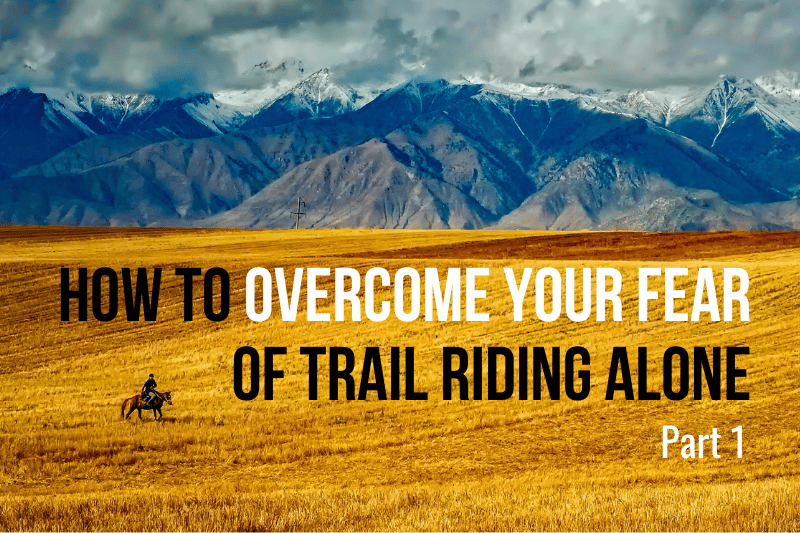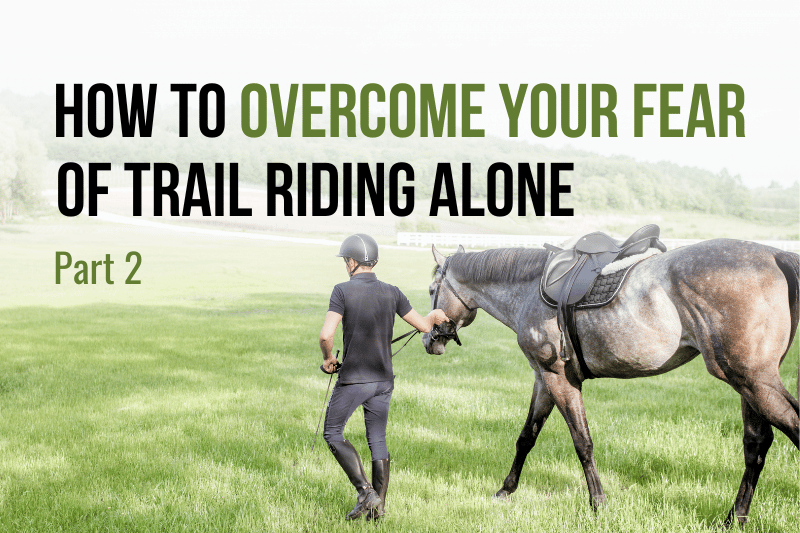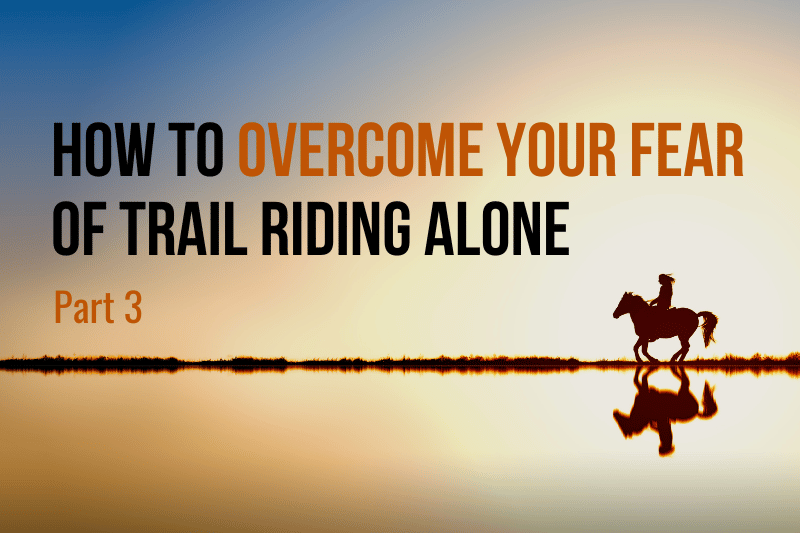Reader Sara asks: Can you talk more about getting over fear? I want to try endurance riding but I work weekends, so I’d have to do most of my training rides by myself during the week. The problem is that I’m terrified of trail riding alone!
I hear you, Sara. As you know, I had quite a journey through fear myself after a bad wreck. Riding horses is inherently risky, and being alone does make it harder to get out of a sticky situation. Respecting your fear is prudent, but it needn’t be paralyzing.
As I gathered my thoughts about dealing with fear, I found myself putting possible solutions into two buckets: practical strategies and psychological strategies. Step one is to identify which of these should be your focus.
This article will help you step back to better understand your experience of fear. Additional posts in this series cover practical and psychological strategies for overcoming your fear of riding alone. Finally, we’ll consider some safety gear that goes way beyond helmets.
Why Are You Afraid of Riding Alone?
Your experience of fear likely shows up as generalized dread. You may feel it between your shoulders or in the pit of your stomach. Perhaps you procrastinate or make excuses not to ride. But have you considered exactly what it is about riding alone that scares you?
Perhaps you are afraid of:
- Losing your horse miles from the trailer
- Getting injured in a fall
- Being unable to control your horse
- Encountering dangerous people or animals
Close your eyes and imagine through the entire process of going for a solo ride, from catching your horse to unsaddling him.
What part of the scenario provokes anxiety?
Try to put your finger on where your lack of confidence is coming from. Is it your personal riding ability, a past incident, a horse behavior issue, or something else? You might even realize that your fear isn’t about riding at all, but about towing the horse trailer!
Here’s an example: I, personally, love trail riding alone. However, I do have a specific riding-related fear. My rescue horse, Pixar, is a big National Show Horse with a shady past that features violently throwing riders. Having once broken my back getting bucked off by a different horse, I am definitely afraid of another injury. My specific fear is of getting hurt because Pixar bucks me off .
Your turn. What exactly are you afraid of? Go ahead, jot it down. I’ll wait…
Got it?
Excellent. Understanding exactly what you’re afraid of is the first step toward addressing that fear.
Is Your Fear of Riding Alone Proportional to Actual Risk?
Now that we’ve identified our specific fears, let’s ponder whether our level of anxiety is proportional to the actual risk.
To help, we’re going to use this chart:
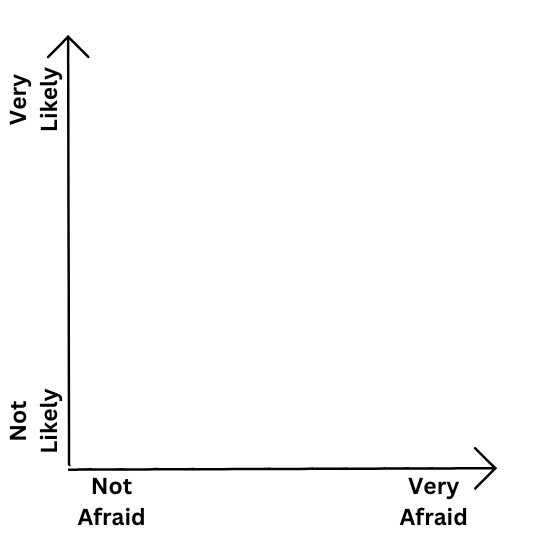
As you can see, the horizontal axis lets you rate your level of fear. On a scale of “not afraid” to “very afraid,” where do you fall?
The vertical axis lets you rate the likelihood that the thing you’re afraid of will actually happen. How likely is the experience your fear? (It might help to get a friend or instructor’s opinion on this.)
Now, place a dot on the chart where your fear level and likelihood intersect.
Let’s go back to my example with Pixar:
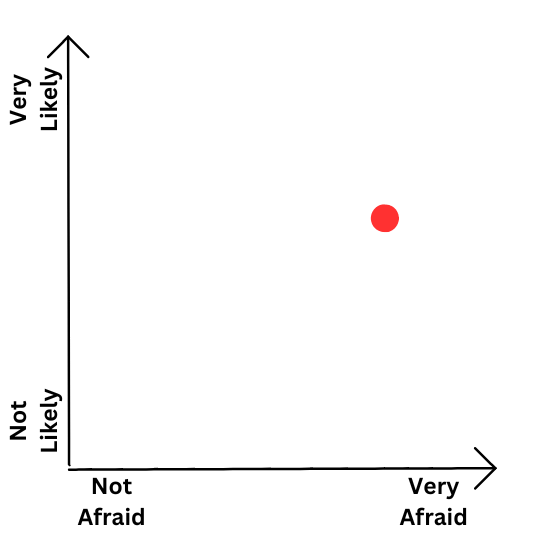
Because I got badly hurt in the past, my fear level of getting bucked off is pretty high. I’d say about an 8 out of 10.
How likely is it that I’ll get hurt because Pixar bucks me off? Well… I’ve painstakingly retrained him from the very beginning without incident. However, he’s still an uptight guy who realizes he can get a rider off if he wants to. He’s known to buck hard, and I’m no bronc rider, so he could definitely toss me. I’m going to give likelihood about a 6 out of 10.
The red dot on the chart represents the intersection between my fear level and the likelihood that I’ll get hurt.
Okay, your turn. Try placing your specific fear on the chart.
Got it?
Next, we’re going to determine whether dealing with this particular fear requires a practical focus or a psychological focus.
Is the Solution to Your Fear Practical or Psychological?
Let’s overlay a quadrant on our chart:
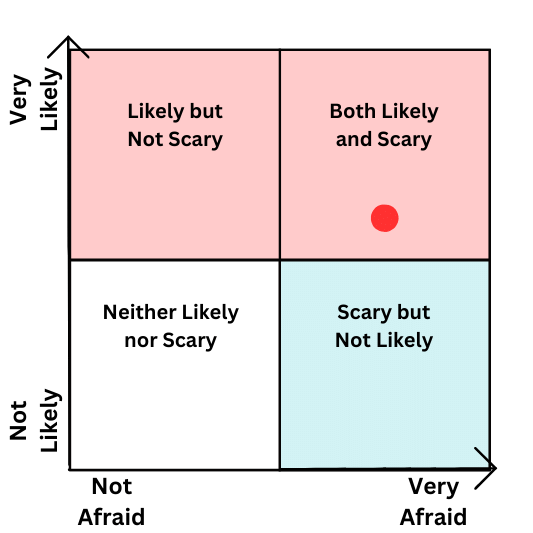
As you can see, your dot is going to fall in one of four boxes: Likely but Not Scary, Both Likely and Scary, Neither Likely nor Scary, or Scary but Not Likely.
My fear of getting bucked off Pixar falls within the Both Likely and Scary quadrant. Lucky me!
Where does yours fall?
If you landed in a pink quadrant, like I did, the thing that scares you likely has a practical solution. Regardless of your actual level of fear, the scary thing really could happen. The good news is that you can break down the danger into fixable pieces.
If you landed in the blue quadrant, the thing that scares you likely requires more of a psychological approach. That certainly doesn’t mean your fear isn’t real. It just means the thing you’re scared of isn’t likely to actually happen, but your mind and body still need convincing.
If you landed in the white quadrant, you’re probably managing mild fear of something unlikely by taking reasonable safety measures and keeping your imagination under control. Well done!
Of course, the nature of any fear falls along a spectrum. There’s a good chance that you’ll benefit from both practical and psychological steps to overcome your fear of riding alone.
The next two posts in this series provide nuts-and-bolts tips for practical and psychological approaches to resolving fear of trail riding alone. The final post will cover horse riding safety measures every equestrian should consider.
Afraid you’ll miss it? Subscribe to my newsletter for a heads-up on new posts.
Is there a topic you’d like me to cover? I want to hear it! Shoot me an email at tamara@thesweatyequestrian.com or ping me on Facebook.

